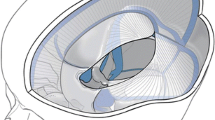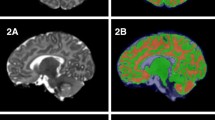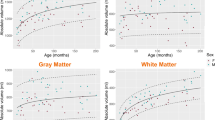Abstract
This study investigated age- and sex-related changes in the volumetric development and asymmetry of the normal hypothalamus from birth to 18. Individuals aged 0–18 with MRI from 2012 to 2020 were selected for this retrospective study. Seven hundred individuals (369 [52.7%] Males) who had 3D-T1 sequences and were radiologically normal were included in the study. Hypothalamus volume was calculated using MRICloud automated segmentation pipelines. Hypothalamus asymmetry was calculated as the difference between right and left volumes divided by the mean (in percent). The measurement results of 23 age groups were analyzed with SPSS (ver.23). The mean hypothalamic volume in the first year of life reached 69% of the mean hypothalamic volume between 0 and 18 years (1119.01 ± 196.09 mm3), 88% in the second year. The mean volume of the hypothalamus without mammillary body increased in the five-age segment, while it increased in the six-age segment with mammillary body. Although the hypothalamus volumes of males were larger than females in all age groups, a significant difference was found between the age groups of 3–8 and 12–18 years (p < 0.05). In the pediatric brain, the hypothalamus was right-lateralized between 2.39% and 14.02%. The first 2 years of life were critical in the volumetric development of the hypothalamus. A segmental and logarithmic increase in the hypothalamus volume was demonstrated. In the pediatric brain, asymmetry and sexual dimorphism were detected in the hypothalamus. Information on normal hypothalamus structure and development facilitates the recognition of abnormal developmental trajectories.



Similar content being viewed by others
Data availability
Not applicable. The use of the data set created and analyzed during the current study is not publicly available as it requires local ethics committee approval.
References
Baroncini M, Jissendi P, Balland E et al (2012) MRI atlas of the human hypothalamus. Neuroimage 59:168–180. https://doi.org/10.1016/j.neuroimage.2011.07.013
Billot B, Bocchetta M, Todd E et al (2020) Automated segmentation of the hypothalamus and associated subunits in brain MRI. Neuroimage. https://doi.org/10.1016/J.NEUROIMAGE.2020.117287
Chen Z, Chen X, Liu M et al (2019) Volume of hypothalamus as a diagnostic biomarker of chronic migraine. Front Neurol. https://doi.org/10.3389/fneur.2019.00606
Eiholzer U, Bachmann S, L’Allemand D (2000) Is there growth hormone deficiency in prader-willi syndrome? Horm Res Paediatr 53:44–52. https://doi.org/10.1159/000023533
Ferna A, Kruijver FP, Fodor M, Swaab DF (2000) Sex differences in the distribution of androgen receptors in the human hypothalamus. J Comp Neurol 425:422–435. https://doi.org/10.1002/1096-9861
Gabery S, Georgiou-Karistianis N, Lundh SH et al (2015) Volumetric analysis of the hypothalamus in huntington disease using 3T MRI: the IMAGE-HD study. PLoS ONE. https://doi.org/10.1371/journal.pone.0117593
Gerendai I, Rotsztejn W, Marchetti B et al (1978) Unilateral ovariectomy-induced luteinizing hormone-releasing hormone content changes in the two halves of the mediobasal hypothalamus. Neurosci Lett 9:333–336. https://doi.org/10.1016/0304-3940(78)90204-5
Giedd JN, Snell JW, Lange N et al (1996) Quantitative magnetic resonance imaging of human brain development: ages 4–18. Cereb Cortex 6:551–560. https://doi.org/10.1093/cercor/6.4.551
Gilmore JH, Shi F, Woolson SL et al (2012) Longitudinal development of cortical and subcortical gray matter from birth to 2 years. Cereb Cortex 22:2478–2485. https://doi.org/10.1093/cercor/bhr327
Goldstein JM, Seidman LJ, Horton NJ et al (2001) Normal sexual dimorphism of the adult human brain assessed by in vivo magnetic resonance imaging. Cereb Cortex 11:490–497. https://doi.org/10.1093/cercor/11.6.490
Goldstein JM, Seidman LJ, Makris N et al (2007) Hypothalamic abnormalities in schizophrenia: sex effects and genetic vulnerability. Biol Psychiatry 61:935–945. https://doi.org/10.1016/j.biopsych.2006.06.027
Ha J, Cohen JI, Tirsi A, Convit A (2013) Association of obesity-mediated insulin resistance and hypothalamic volumes: possible sex differences. Dis Markers 35:249–259. https://doi.org/10.1155/2013/531736
Hulshoff Pol HE, Cohen-Kettenis PT, Van Haren NEM et al (2006) Changing your sex changes your brain: influences of testosterone and estrogen on adult human brain structure. Eur J Endocrinol. https://doi.org/10.1530/eje.1.02248
Kiss DS, Toth I, Jocsak G et al (2020) Metabolic lateralization in the hypothalamus of male rats related to reproductive and satiety states. Reprod Sci 27:1197–1205. https://doi.org/10.1007/S43032-019-00131-3
Klomp A, Koolschijn PCMP, Hulshoff Pol HE et al (2012) Hypothalamus and pituitary volume in schizophrenia: a structural MRI study. Int J Neuropsychopharmacol 15:281–288. https://doi.org/10.1017/S1461145711000794
Koolschijn PCMP, van Haren NEM, Hulshoff Pol HE, Kahn RS (2008) Hypothalamus volume in twin pairs discordant for schizophrenia. Eur Neuropsychopharmacol 18:312–315. https://doi.org/10.1016/j.euroneuro.2007.12.004
Makris N, Swaab DF, van der Kouwe A et al (2013) Volumetric parcellation methodology of the human hypothalamus in neuroimaging: normative data and sex differences. Neuroimage 69:1–10. https://doi.org/10.1016/j.neuroimage.2012.12.008
Mori S, Wu D, Ceritoglu C et al (2016) MRICloud: delivering high-throughput MRI neuroinformatics as cloud-based software as a service. Comput Sci Eng 18:21–35. https://doi.org/10.1109/MCSE.2016.93
Neudorfer C, Germann J, Elias GJB et al (2020) A high-resolution in vivo magnetic resonance imaging atlas of the human hypothalamic region. Sci Data. https://doi.org/10.1038/S41597-020-00644-6
Nieuwenhuys R, Voogd J, Van Huijzen C (2008) The human central nervous system. Springer, Berlin
Østby Y, Tamnes CK, Fjell AM et al (2009) Heterogeneity in subcortical brain development: a structural magnetic resonance imaging study of brain maturation from 8 to 30 years. J Neurosci 29:11772–11782. https://doi.org/10.1523/JNEUROSCI.1242-09.2009
Overeem S, Van Vliet JA, Lammers GJ et al (2002) The hypothalamus in episodic brain disorders. Lancet Neurol 1:437–444
Peper JS, Brouwer RM, Schnack HG et al (2009) Sex steroids and brain structure in pubertal boys and girls. Psychoneuroendocrinology 34:332–342. https://doi.org/10.1016/j.psyneuen.2008.09.012
Peper JS, Brouwer RM, van Leeuwen M et al (2010) HPG-axis hormones during puberty: a study on the association with hypothalamic and pituitary volumes. Psychoneuroendocrinology 35:133–140. https://doi.org/10.1016/j.psyneuen.2009.05.025
Saper CB, Lowell BB (2014) The hypothalamus. Curr Biol 24:R1111–R1116. https://doi.org/10.1016/j.cub.2014.10.023
Schindler S, Schönknecht P, Schmidt L et al (2013) Development and evaluation of an algorithm for the computer-assisted segmentation of the human hypothalamus on 7-Tesla magnetic resonance images. PLoS ONE. https://doi.org/10.1371/journal.pone.0066394
Sparks DL, Hunsaker JC (1991) Sudden infant death syndrome: altered aminergic-cholinergic synaptic markers in hypothalamus. J Child Neurol 6:335–339. https://doi.org/10.1177/088307389100600409
Swaab DF (2006) The human hypothalamus in metabolic and episodic disorders. Prog Brain Res 153:3–45
Swaab DF, Fliers E (1985) A sexually dimorphic nucleus in the human brain. Science 228:1112–1115. https://doi.org/10.1126/science.3992248
Swaab DF, Hofman MA (1995) Sexual differentiation of the human hypothalamus in relation to gender and sexual orientation. Trends Neurosci 18:264–270
Swaab DF, Gooren LJG, Hofman MA (1992) The human hypothalamus in relation to gender and sexual orientation. Prog Brain Res 93:205–219. https://doi.org/10.1016/S0079-6123(08)64573-2
Tang X, Crocetti D, Kutten K et al (2015) Segmentation of brain magnetic resonance images based on multi-atlas likelihood fusion: testing using data with a broad range of anatomical and photometric profiles. Front Neurosci. https://doi.org/10.3389/FNINS.2015.00061
Terlevic R, Isola M, Ragogna M et al (2013) Decreased hypothalamus volumes in generalized anxiety disorder but not in panic disorder. J Affect Disord 146:390–394. https://doi.org/10.1016/j.jad.2012.09.024
Tognin S, Rambaldelli G, Perlini C et al (2012) Enlarged hypothalamic volumes in schizophrenia. Psychiatry Res 204:75–81. https://doi.org/10.1016/j.pscychresns.2012.10.006
Toth I, Kiss DS, Goszleth G et al (2014) Hypothalamic sidedness in mitochondrial metabolism: new perspectives. Reprod Sci 21:1492–1498. https://doi.org/10.1177/1933719114530188
Toth I, Kiss DS, Jocsak G et al (2015) Estrogen- and satiety state-dependent metabolic lateralization in the hypothalamus of female rats. PLoS ONE. https://doi.org/10.1371/JOURNAL.PONE.0137462
Wu D, Ma T, Ceritoglu C et al (2016) Resource atlases for multi-atlas brain segmentations with multiple ontology levels based on T1-weighted MRI. Neuroimage 125:120–130. https://doi.org/10.1016/J.NEUROIMAGE.2015.10.042
Funding
No funding was received for conducting this study.
Author information
Authors and Affiliations
Contributions
SI: conceived the idea, collected data, interpreted the results, performed the literature search, and wrote the manuscript. SO: performed the literature search and revised the work critically. GO: designed the statistical modeling, performed the analysis, and supervised the manuscript. RO: Determined whether the radiological materials to be included in the study were suitable for evaluation and critically revised the manuscript. All authors read and approved the final version of the manuscript.
Corresponding author
Ethics declarations
Competing interests
The authors declare no competing interests.
Conflict of interest
The authors have no competing interests to declare that are relevant to the content of this article.
Ethical approval
This retrospective study involving human participants was in accordance with the ethical standards of the institutional and national research committee and with the 1964 Helsinki Declaration and its later amendments or comparable ethical standards. This study was approved by the Ethics Committee of Clinical Investigations of the Bursa Uludag University Faculty of Medicine (2022–1/12, 05.01.2022).
Informed consent
As this study was retrospective, radiological images were used with the approval of the ethics committee without obtaining an informed consent form.
Additional information
Publisher's Note
Springer Nature remains neutral with regard to jurisdictional claims in published maps and institutional affiliations.
Rights and permissions
Springer Nature or its licensor holds exclusive rights to this article under a publishing agreement with the author(s) or other rightsholder(s); author self-archiving of the accepted manuscript version of this article is solely governed by the terms of such publishing agreement and applicable law.
About this article
Cite this article
Isıklar, S., Turan Ozdemir, S., Ozkaya, G. et al. Hypothalamic volume and asymmetry in the pediatric population: a retrospective MRI study. Brain Struct Funct 227, 2489–2501 (2022). https://doi.org/10.1007/s00429-022-02542-6
Received:
Accepted:
Published:
Issue Date:
DOI: https://doi.org/10.1007/s00429-022-02542-6




